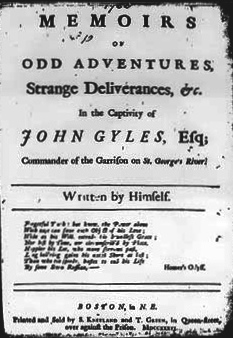John Gyles facts for kids
John Gyles (born around 1680 in Pemaquid, Maine, died 1755 in Roxbury, Boston) was an important interpreter and soldier. He is best known for writing a book about his time living with the Maliseet tribes. He was held captive at their main village, Meductic, located on the Saint John River.
Contents
Captured in King William's War
In 1689, when John Gyles was just nine years old, a big war called King William's War was happening. He was living with his family near Fort Charles in Maine.
On August 2, while working with his father, Thomas, near the new fort, John was captured by Maliseet warriors. This happened during an attack on the fort known as the Siege of Pemaquid (1689). Sadly, his father was killed. One of his brothers was taken by another tribe, the Penobscot, and only one brother managed to escape.
John was taken on a long journey. He traveled up the Penobscot River, then carried across land (called a portage) to the Chiputneticook Lakes. From there, he was taken to the main Maliseet village of Meductic.
Life as a Captive
For six years, John Gyles was held captive by the Maliseets. He was made to do difficult work for small hunting groups that traveled far north, even to Gaspésie. He faced many challenges and harsh conditions during this time.
Things got much better for John in the summer of 1695. He was sold to Louis D'Amours de Chauffours, a French landowner who lived in Jemseg. John hunted and traded goods for D'Amours and also worked in his store.
In October 1696, English soldiers came up the Saint John River. They were planning to attack the capital of Acadia in what was called the Siege of Fort Nashwaak. D'Amours was away in France at the time. However, John Gyles helped protect his master's house from being destroyed. He put a note on the door, written by D'Amours' wife, saying that English captives had been treated kindly there.
After the war ended with the Treaty of Ryswick, John Gyles was finally set free. He was given to the captain of an English ship at the mouth of the Saint John River. He sailed to Boston and arrived there on June 19, 1698.
Serving in Queen Anne's War
When another war, Queen Anne's War, started in 1701, John Gyles became very important. His knowledge of the local Native American languages in Acadia made him extremely valuable to the leaders of New England.
During this war, he worked as an interpreter for many peace talks. He sailed with Major Benjamin Church in 1704. He also fought alongside Colonel John March at the Siege of Port Royal (1707).
Later Military Service
Most of John Gyles' later life was spent in military service. He also worked as a go-between, helping to communicate with Native American groups.
In 1715, he helped build Fort George in Brunswick. This fort was attacked in 1722 during Dummer's War, also known as Father Rale's War. John Gyles stayed to command the fort throughout this war, until 1725. He finished his military career as the commander of the New England soldiers at Fort St. George (Thomaston, Maine).
John Gyles married his first wife, Ruth True, in 1703. Later, he married his second wife, Hannah Heath, in 1722.
John Gyles' Legacy
In 1736, John Gyles published his famous book about his adventures. It was first printed in Boston. The book was reprinted many times, including in 1853 and 1875. A modern version of his story was even made in 1966 by Stuart Trueman.
His book is seen as an early example of "frontier romances." These are adventure stories set in the American wilderness, similar to later works by famous writers like James Fenimore Cooper.
A place called Gyles Cove, located north of Hillman in York County, New Brunswick, was named after him.
In 1978, a play about his life, called John Gyles: an Indian Experience, was produced by Theatre New Brunswick's Young Company.
Images for kids



